#the bestiary
Text
It's Time for the Shadecursed Free Book Weekend!

Why, hello there! Meadow's here to tell you about a GREAT OFFER. In fact, it's so great that it won't cost you a thing! Shadecursed is on sale RIGHT NOW for the low, low, LOW price of $Free!
For those who haven't been following me, Shadecursed is the first book in a trilogy, which follows a faun named Meadow and his friends on a quest to save the whole planet! Enjoy a humor-filled adventure as they try to discover the secret behind the disappearance of a goddess!
It might seem counterproductive to give my book away, but it's got some pretty sweet benefits:
The more people download it, the more likely it is to end up in people's suggestions.
The more people download it, the more likely I am to get reviews and/or ratings, which help me with the algorithm.
I just want people to read this story that I spent five years working on.
You get a FREE BOOK. IT'S FREE BOOK ESTATE.
Check it out here, and grab it while you can: https://mybook.to/QCpQ
Clicking on the button to get it for free is a great help, even if you don't intend to read it right now. Or ever! Help an indie author out. It only takes a few seconds and you get a free book out of the deal!
And yes, reblogging this post is an amazing help, too. <3 Thank you in advance. Let's see if I can push Shadecursed to the top 100 this weekend!
#writing#indie book#indie author#fantasy#fantasy novel#fantasy book#faun#manticore#harpy#werewolf#free books#shadecursed#the bestiary
21 notes
·
View notes
Photo

Greater devils of the lowest planes of Hades: Shedim and Asura. The Shedim are the most powerful and serve as personal bodyguards of Asmodeus; the Asura, or Pit Devils, are the largest servants of the arch devils and oversee the slave pits and mines. (Bill Sienkiewicz, The Bestiary: A compendium of creatures and beings from the lost world of Atlantis by Stephan Michael Sechi and J Andrew Keith, Bard Games, 1986)
#D&D#Dungeons & Dragons#Bill Sienkiewicz#devil#devils#dnd#Bard Games#Atlantis#Atlantean Trilogy#The Bestiary#shedim#asura#Hades
145 notes
·
View notes
Text

⭐️ - umm my friends and i started a don’t dig up world today so i made an oc for it 🐰
some trivia for them under the cut :]
she sings really really well but other than that he doesn’t really talk much if at all
due to having to fly with his arms they actually use their legs to use bows and stuff (and it actually works pretty well)
her favorite biome is the ocean, least favorite is the underground (which is ironic considering what secret seed i’m using him for…)
he is a vegetarian
#⭐️ - hopefully she and flynn can actually share space in my head instead of me forgetting about them after a week and thinking about flynn#⭐️ - instead ahfhsj#terraria#terraria oc#spectre brush#the bestiary#aegis
13 notes
·
View notes
Text

He is busy watching the wildlife of his “ship” go about their lives.
The Swooshes go “swoosh”.
The Sways go “sway”.
The Hades Mages are just creepy.
#「 state of affairs 」#( I still need to continue working on the next part of that Heavenly Ship headcanon thing#the bestiary#it will be most fun )#(maybe I'll get to that today )
3 notes
·
View notes
Text
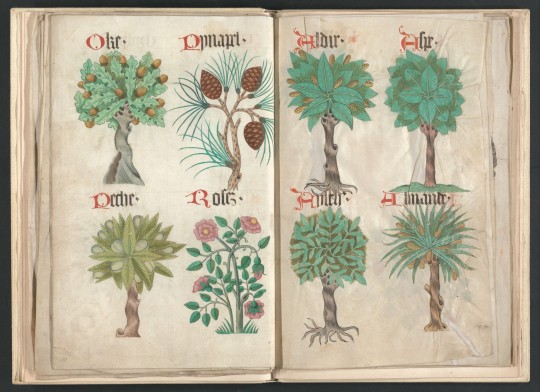
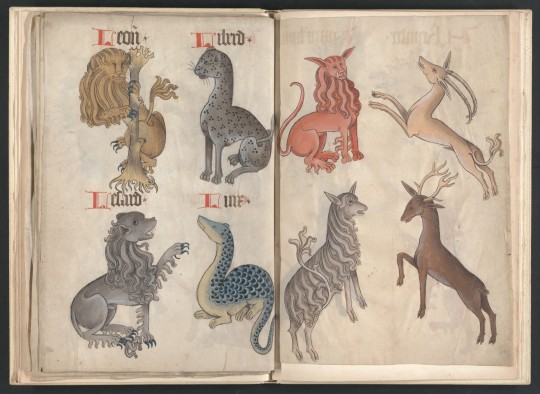


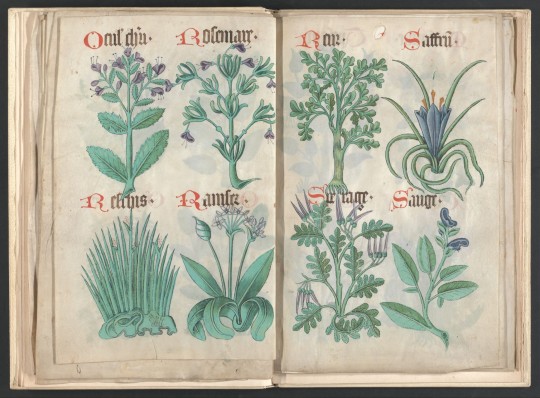

~ Helmingham herbal and bestiary.
Place oforigin/Published: Helmingham, Suffolk
Date: ca. 1500

5K notes
·
View notes
Text
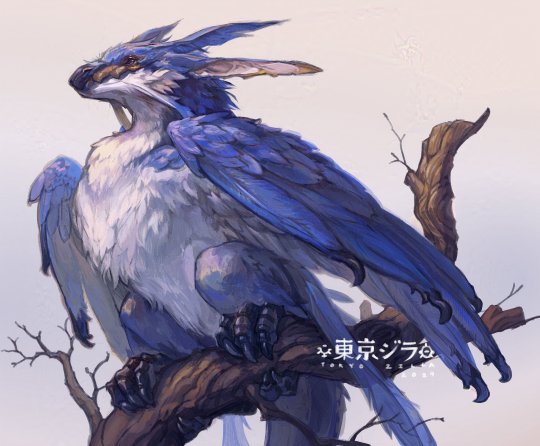
Junjur kite - Bestiary log piece

close up shot
more info on them are available on my patreon :3
3K notes
·
View notes
Text


A two for one post today.
Dragon posts for Smaugust.
The Maple Leaf Drake is a small to medium sized woodland dragon that populates temperate forests across the globe. Their unique body morphology allows them to hide, almost seamlessly, amongst vast maple forests. This physiological adaptation also extends to seasonal color changes throughout the year. They will live their lives hidden amongst the leaves, using their long proboscis bill to pierce through the bark of Maple Trees to extract the sweet sap, which makes up the majority of it’s diet.
Incredibly skittish, the Fearful Precious Red Coral Drake lives it’s life hidden amongst Red Coral. It’s long proboscis-like mouth snatching up small unsuspecting pray.
#concept art#creature design#fantasy art#creature concept#concept design#monster#creature#dragons#speculative evolution#sea monster#sea dragon#maple tree#forest spirit#fantasy illustration#bestiary#forest dragon#dragon concept art#smaugust#smaugust 2023
5K notes
·
View notes
Text
The "shrimp colors" meme is part of a long and storied tradition of attributing wonderfully poetic, metaphorically rich, and completely spurious properties to animals and plants. Irises grow from lightning-struck ground, the pelican revives her chicks by drawing blood from her breast with her beak, weasels conceive through the mouth and give birth through the ear canal, the eagle flies up to the sun to burn old age from his eyes, and mantis shrimp see colors we cannot imagine.
It's the kind of thing that fills medieval bestiaries, folk medical traditions, and the writings of Pliny the Elder.
2K notes
·
View notes
Text

Collectable woodblock prints commemorating individual conquests were commonplace in the theocracy, distributed by the church as a way to announce its victories.
get a print here :>
#setting: mez#just wanted to draw something mindless & fun tonight. what's up#medieval bestiary art#fantasy worldbuilding#pantera got the final blow in with aid from the other pictured beests
3K notes
·
View notes
Photo
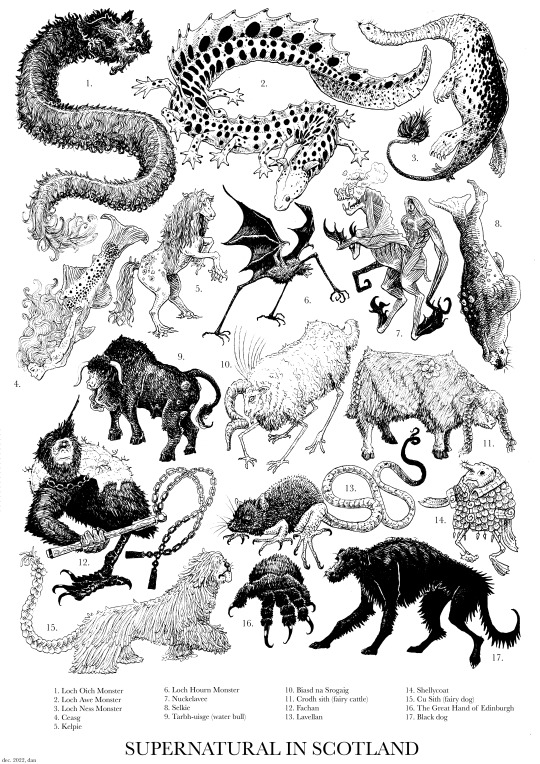
#i gave the original to my cousin for christmas !!#i kept it b&w i was afraid that the different colors wouldnt match together#illustration#monster#bestiary#creature design#Supernatural in Scotland#Scotland#folklore#Europe
11K notes
·
View notes
Text

We have our first kobold! This is Tregna, one of my Kickstarter backers' requests.
Kobolds live in the arctic parts of Erit, and are extremely comfortable in the cold. This is typical dress for the equivalent of -35 degrees Celcius (-31 degrees Fahrenheit).
Two species descended from the now-extinct kobla--kobolds like Tregna, and orcs. Both need to wear protective clothing when traveling outside their native temperature zone. For kobolds, they wear belts, wrist cuffs, and ankle cuffs. Tregna is wearing the belt in this image, but it seems she got distracted while getting ready to venture into warmer climates, because she's not wearing her cuffs.
Kobolds are great swimmers. Their diet consists of cold-climate fish and other marine animals that can withstand the frigid temperatures of their home.
Some members of this species claim they can hear and communicate with dragons, but this has never been proven.
Create Don't Scrape Warning: This image is Glazed.
29 notes
·
View notes
Photo
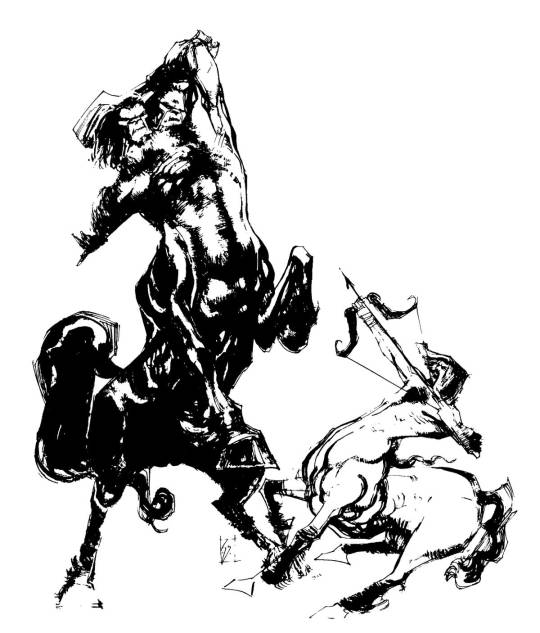
“The typical Arcitenus is stronger and much larger than an ordinary centaur, and possessed of two heads, rather than one, on broad, muscular shoulders.” (Bill Sienkiewicz illustration from The Bestiary: A compendium of creatures and beings from the lost world of Atlantis by Stephan Michael Sechi and J Andrew Keith, Bard Games, 1986)
#D&D#Dungeons & Dragons#Bill Sienkiewicz#centaur#Atlantis#The Bestiary#Atlantean Trilogy#arcitenus#Bard Games#dnd#two headed centaur
97 notes
·
View notes
Text
⭐️ - also i have a bunch of headcanons for candy (my party girl) in particular and i’m not entirely sure why. but anyway
her hair is dyed pink, her natural hair color is a reddish brown
she can rollerskate
she types like a 2000s - early 2010s internet user (emoticons, “rawr”, you get the deal)
she hangs out with tyler (the angler) and momo (the princess) a ton and they view her as a big sister in a way … she also gets them stuff like junk food when their respective caretakers won’t let them have any
she owns a guitar modeled after the stellar tune (but it’s not an actual stellar tune) and is still kinda amateur at playing it … the kids and/or hayley (the zoologist) like to visit her to watch her practice and if tyler’s there he likes to mess with her equipment (change the volume or settings on the amp, change the tuning to the point where it sounds Very Bad, etc)
#⭐️ - anywayyy yeah i just think she’s neat :]#terraria#terraria party girl#repeated fallen star noises#the bestiary#candy#tyler#momo#hayley
11 notes
·
View notes
Text
Excerpt from Chapter 1 of Eric Quayle's Early Children's Books: A Collector's Guide (1983)
FROM WILL SHAKESPEARE TO WILL WYCHERLEY, pp. 12-14
"The percentage of children who could read or look at picture books in the Middle Ages was minutely small, and even these favoured few could seldom have been allowed to handle personally the illuminated manuscripts which depicted, often in graphic and exciting form, the myths and legends of earlier days in religious history. One can imagine a kindly monk lifting up a wondering boy as he turned the vellum leaves and told the story they unfolded . . . A fanciful picture of a scene more likely to have been enacted between a pedagogue and his pupil in the latter half of the fifteenth century, the boy being taught his alphabet and figures by repeating the letters from his horn-book.
"Reading for pleasure was practically unknown for the young of those days, and, not surprisingly, few, if any, juvenile manuscripts that may have passed from hand to hand have survived. After the invention of printing with movable metal type about 1456, and the setting up of William Caxton's press at Westminster about twenty years later, there was still to be a long wait before any work remotely interesting to children made its appearance. Then, on 26 March 1484, 'in the first year of the reign of King Richard the Third,' Caxton finished his translation from the French of Aesop's Fables. The book of the subtyl hystoryes and Fables of Esope, with its woodcut illustrations, was not in any way intended by Caxton as a text for the young, but, since this first translation into English nearly five hundred years ago, the work in various forms and illustrated by scores of artists has remained in print almost exclusively for a juvenile audience.
"One of the most popular collection of of tales of the Middle Ages was Gesta Romanorum, compiled in Latin, almost certainly in England, around 1300, which appeared in manuscript in English during the fifteenth century. The Acts of the Romans, as it was usually called, is believed to have been written in order to supply a series of entertaining stories for regaling the brothers of an unidentified abbey and was probably compiled by one of their number to lighten the long nights of winter. The earliest manuscript versions differ widely in the tales they tell, but all are romances of chivalry and legends of saintly deeds, and to each of the stories a moral is attached. They supplied material for many subsequent authors, and in modified form provided the sort of adventure story reading beloved of children. Long before the invention of printing the youth of the fourteenth and fifteenth centuries must have thrilled to the accounts of Roman heroes dressed as they were in the garb of early medieval knights, slaying Greeks and dragons with equal impunity. Caxton's successor, Wynkyn de Worde, who had joined the master in London in 1477, and who inherited Caxton's press on his death in 1491, was the first to print Gesta Romanorum. Versions of his text, in abbreviated form and illustrated with crude little woodcuts, were read by children for their own amusement throughout the next four centuries, many carrying little homilies on their title-pages, such as:
"The Story's pleasant, and the moral good,
If read with Care, and rightly understood.
"Another favourite with children must have been the various Bestiaries, described by M. R. James in his treatise on the subject, The Bestiary, 1928, as 'one of the leading picture-books of the twelfth and thirteenth centuries in this country.' These were early natural history, with many of the animals depicted being fabulous, but none the less fearsome for that. The Voiage and Travaile of Sir John Maundevile, Kt, a purely fictitious work written originally in French, purported to be a guide to pilgrims to the Holy Land, and must have proved extremely entertaining to youth from the middle of the fourteenth century onwards with its tales of ant-hills of gold dust; tribes of one-footed men 'and the foot so large that it shadeth all the Body against the Sonne when they lye down and raze it'; of wells whose water changes colour at the stroke of every hour; trees which bear honey and whose sap is wine; a one-eyed tribe, with the orb in the centre of their foreheads; and much more in the same vein with pictures to prove the statements true.
"None of these works was in any way intended for children, either in manuscript or in later book form, and we have to wait until the final quarter of the sixteenth century, to a time when William Shakespeare was a boy of sixteen, before the first purpose-made picture book for children made its appearance.
"Kunst und Lehrbüchlein was first published in Germany in 1578, but this issue was merely a hotch-potch of illustrations culled from a variety of works which the publisher, Sigmund Feyerabend (1528-1590), had commissioned during the previous decade. Book of Art and Instruction for Young People, to give the work its English title, was re-issued in 1580 as a book specially prepared for the youth of the day."
#Wynkyn de Worde#children's books#books#history of books#book collecting#middle ages#medieval#legends#romances#woodcuts#illustrations#William Caxton#picture books#The Travels of Sir John Mandeville#the bestiary#bestiaries#m. r. james#aesop's fables
1 note
·
View note
Text


les animaux de l'histoire
893 notes
·
View notes

